Masterbatch Additive
Price 70 INR/ Kilograms
Masterbatch Additive Specification
- Color
- White
- Storage
- Cool, dry place, sealed
- b*
- 2.50
- Moisture
- 0.3%
- Particle Size
- 12 m
- E*
- 0.90
- CAS No
- 13463-67-7
- Weather Resistance
- Excellent
- Acid Resistance
- Excellent
- Alkali Resistance
- Good
- Volatile Matter (%)
- 0.5%
- a*
- -0.20
- L*
- 96.5
- Style
- Masterbatch Additive
- Water Insoluble
- 0.1%
- Ingredients
- Titanium Dioxide, Polyethylene, Additives
Masterbatch Additive Trade Information
- Minimum Order Quantity
- 1 Kilograms
- Supply Ability
- 50000 Kilograms Per Week
- Delivery Time
- 3-7 Days
- Main Export Market(s)
- Asia, Australia, Central America, North America, South America, Eastern Europe, Western Europe, Middle East
About Masterbatch Additive
Masterbatch is non-wrapping and non-shrinking in nature. These pigments prove perfect for masterbatch applications owing to their exceptional heat and light stability. This pigment is extensively utilized in applications that need improved appearance as regards brightness, surface smoothness, and transparency. This color masterbatch also offers better mechanical properties favored for manufacturing of thin pressure pipes, films, fibres, bottles, etc. Moreover, the leather industry uses sodium bisulfite to make refined leather products more waterproof, wearable, and long lasting. It is also uses as a food preservative; the food industry also utilizes sodium bisulfite as a bleaching agent.
Superior Compatibility and Dispersibility
Tailored for seamless integration with PE and PP resins, the white masterbatch additive delivers high dispersibility, facilitating optimal opacity and brightness throughout polymer blends. Its polyethylene carrier and controlled particle size (12 m) promote a homogeneous distribution, reducing common processing issues such as streaks or uneven coloration.
Robust Performance Across Applications
Engineered for demanding industrial uses including film, injection molding, blow molding, and extrusion, this additive withstands high-temperatures (300C) and maintains stable optical properties. Its excellent resistance to acids, weathering, and good alkali resistance ensure enduring product quality in diverse environments.
Safe, Efficient, and Easy Handling
This non-toxic, odorless masterbatch is supplied in convenient 25 kg bags, ensuring easy measuring and storage. With low moisture and volatile matter, it ensures consistent processing and long-term stability. Recommended for use at 25% by weight, manufacturers benefit from simplified dosing and reliable results.
FAQs of Masterbatch Additive:
Q: How should the masterbatch additive be incorporated into PE or PP resin during processing?
A: The masterbatch additive should be pre-mixed with PE or PP granules at a recommended dosage of 25% by weight. Uniform blending before extrusion, molding, or film production ensures high dispersibility and optimal coloration throughout the final product.Q: What practical benefits does this masterbatch additive offer for film and molding applications?
A: This additive enhances whiteness, opacity, and color consistency while maintaining excellent acid and weather resistance, good alkali resistance, and 300C heat resistance. Its high dispersibility ensures smooth processing, reducing the risk of defects such as streaks or uneven coloration in film, injection, blow, and extrusion applications.Q: When is the optimal time to measure and blend the masterbatch additive into polymer formulations?
A: For best results, measure and blend the masterbatch additive during initial resin preparation prior to commencing the molding or extrusion process. Accurate dosing within 25% by weight guarantees uniform properties and maximized optical performance.Q: Where should the masterbatch additive be stored to maintain its quality and effectiveness?
A: Store the additive in a cool, dry, and sealed environment to prevent exposure to moisture and contaminants. This preserves its shelf life of 12 months and maintains low moisture and volatile content for consistent processing outcomes.Q: What are the main ingredients in this masterbatch additive, and are they safe for handling?
A: The masterbatch contains titanium dioxide, polyethylene, and functional additives. It is classified as non-toxic and odorless, making it safe for handling during typical processing and manufacturing practices.Q: How does the additives heat resistance contribute to manufacturing processes?
A: With heat resistance of 300C, the masterbatch additive withstands high-temperature processing methods such as extrusion, injection molding, and blow molding without degrading or affecting the color quality, supporting consistent product performance.

Price:
- 50
- 100
- 200
- 250
- 500
- 1000+
More Products in Ultramarine Blue Category
Ultramarine for Surface Coating
Price 85 INR / Kilograms
Minimum Order Quantity : 1 Kilograms
Ingredients : Complex Silicate of Sodium & Aluminium (with Sulphur) (Na810Al6Si6O24S24)
Water Insoluble : 98%
Style : Other, Powder
Volatile Matter (%) : 1.0%
Ultramarine Blue for Rubber
Price 65 INR / Kilograms
Minimum Order Quantity : 1 , , Kilograms
Ingredients : Sodium alumino sulpho silicate
Water Insoluble : 0.5%
Style : Other, Powder
Volatile Matter (%) : 2%
Ultramarine Blue Paint Pigments
Price 100 INR / Kilograms
Minimum Order Quantity : 1 Kilograms
Ingredients : Sodium alumino sulfo silicate
Water Insoluble : 0.5% Max
Style : Other, Powder
Volatile Matter (%) : 1% Max
Ultramarine Blue For Paper Industry
Price 90 INR
Minimum Order Quantity : 1 , , Kilograms
Ingredients : Silica, Alumina, Sodium, Sulphur
Water Insoluble : Max. 1.5 %
Style : Other, Powder
Volatile Matter (%) : 1.0 % Max
 |
MEGHA INTERNATIONAL
All Rights Reserved.(Terms of Use) Developed and Managed by Infocom Network Private Limited. |
 English
English Spanish
Spanish French
French German
German Italian
Italian Chinese (Simplified)
Chinese (Simplified) Japanese
Japanese Korean
Korean Arabic
Arabic Portuguese
Portuguese
 Send Inquiry
Send Inquiry




